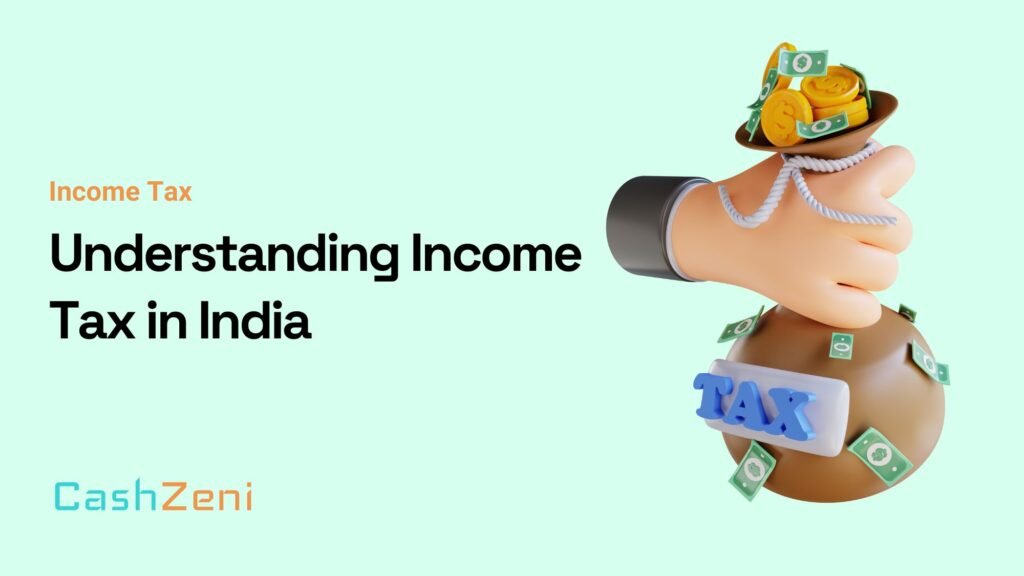An ancient philosopher once said, “The only two certainties in life are death and taxes.” And as we’re not quite ready to delve into metaphysical discussions just yet, we’ll stick to what we know best – taxes, more specifically, income tax in India.
Table of Contents
Income tax is a bit like that spicy Indian curry; it leaves a strong impression, and understanding it might require an adventurous palate. In India, income tax is a vital cog in the machinery of the economy, providing essential funds for infrastructure development, public services, and other nation-building activities.
Given its crucial role, there’s a pressing need for every Indian citizen, whether you’re a high-flying CEO or a fresh-faced intern, to understand the nuances of income tax. But worry not! We at CashZeni are here to hold your hand (metaphorically, of course) and guide you through the maze that is income tax in India. So let’s take the bull by the horns and dive right in.
Who Should Pay Income Tax in India?
When it comes to income tax, not everyone is invited to the party. The Indian government, in all its wisdom, has set up some criteria to decide who gets to contribute to the nation’s treasury. And they’re quite straightforward – age, residency, and income.
In the arena of income tax, you’re an ‘individual taxpayer’ if you’re a resident of India, aged below 60 years, and earn more than the basic exemption limit of INR 2.5 lakh per annum. The age increases to 80 years for super senior citizens with the same income, and if you’re anywhere between 60 and 80 years, you enter the ‘senior citizen’ bracket. Now, if you’re an NRI (Non-Residential Indian), the tax rules change slightly, but the bottom line remains that if you earn income in India, you need to pay tax.
It’s a common misconception that only salaried individuals need to pay income tax. Allow me to debunk this myth; income tax applies to everyone earning above the exemption limit, and this includes income from other sources such as rental income, income from investments, and even winnings from that weekend poker game.
In the next section, we will peel back the layers of the rather intriguing topic of ‘tax slabs’ in India. Buckle up!
Understanding Tax Slabs in India
To further our culinary comparison, consider tax slabs as different heat levels in a delectable biryani. The spicier it gets, the higher the slab you’re in.
For individuals below 60, the party starts at INR 2.5 lakhs. Any income below this is tax-free. Between INR 2.5 lakhs to 5 lakhs, you’re looking at a 5% tax. From 5 lakhs to 10 lakhs, the tax rate simmers at 20%. For income above 10 lakhs, the tax sets your wallet on fire at 30%.
For senior citizens, the first tax-free slab is set at a higher limit of INR 3 lakhs. The rest of the slabs remain the same. For the super senior citizens, the tax-free limit increases to INR 5 lakhs, granting a bit of solace in their golden years.
Corporates too have a seat at this table. Domestic companies have a flat rate of 25%, while foreign companies are taxed at 40% on their Indian income.
What is the Income tax slab?
The taxpayers in India need to pay income tax basis on the income tax slab they fall in. Income tax slab consists of different ranges of income with different tax rates. As income increases, the tax rates also increase. The slab system was introduced to enable a fair tax system in the country. The changes in the income tax slab are done as per the budget announcement.
New Income Tax Slabs For FY 2022-23 (AY 2023-24) as per Budget 2023
As per the Union Budget 2023, a few key changes have been introduced under the new tax regime. The tax slab under the new tax regime has been reduced from 6 to 5, and the basic exemption limit has been raised to Rs. 3 lakh from Rs. 2.5 lakh. These changes will be applicable from 1 April 2023. The slab structure has been revised:-
Income Tax Slab Rate for New Tax Regime
| Range of Income | Tax Rate |
|---|---|
| Upto 3,00,000 | Nil |
| 3,00,000-6,00,000 | 5% |
| 6,00,000-9,00,000 | 10% |
| 9,00,000-12,00,000 | 15% |
| 12,00,000-15,00,000 | 20% |
| Above 15,00,000 | 30% |
The income tax slab rates for the old regime are the same as previous years’ income tax slab rates.
Income Tax Slab Rate for Old Tax Regime
| Range of Income | Tax Rate |
|---|---|
| Up to 2,50,000 | Nil |
| 2,50,000-5,00,000 | 5% |
| 5,00,000-10,00,000 | 20% |
| Above 10,00,000 | 30% |
Decoding Income Tax Forms in India
Income tax forms, or ITR forms, are like a box of assorted chocolates. There’s one for every kind of taxpayer. From ITR-1 (Sahaj) for individuals with an income up to INR 50 lakhs, to ITR-7 for individuals and companies required to furnish a return under sections 139(4A) or 139(4B) or 139(4C) or 139(4D), there’s a form for everyone.
Selecting the correct ITR form is crucial for accurate tax filing. A misstep here could lead to the taxman knocking on your door, and trust me, that’s one visit you want to avoid!
Income Tax Return (ITR) Forms:
- ITR-1 (Sahaj): For individuals with an income up to INR 50 lakhs.
- ITR-2: For individuals and Hindu Undivided Families (HUFs) not having income from profits and gains of business or profession.
- ITR-3: For individuals and HUFs having income from profits and gains of business or profession.
- ITR-4 (Sugam): For presumptive income from Business & Profession.
- ITR-5: For firms, LLPs, AOPs (Association of persons) and BOIs (Body of Individuals), Artificial Juridical Person (AJP), Estate of deceased, Estate of insolvent, Business trust and investment fund.
- ITR-6: For Companies other than companies claiming exemption under section 11 (Income from property held for charitable or religious purposes)
- ITR-7: For persons including companies required to furnish return under section 139(4A) or section 139(4B) or section 139(4C) or section 139(4D) or section 139(4E) or section 139(4F).
Exploring Income Tax Sections
You’ve heard them bandied about in financial discussions – Section 80C, Section 80D, Section 80E. No, these aren’t secret codes from a James Bond film but vital income tax sections that play a crucial role in your tax calculations.
Section 80C is like the Shah Rukh Khan of tax sections, the most popular of the lot. It covers various investments and expenses up to INR 1.5 lakhs, which are exempt from tax. Section 80D swoops in with deductions on health insurance premiums, while Section 80E offers relief on the interest paid on education loans. And there are many more.
Each section caters to a different aspect of your financial landscape, providing tax-saving opportunities. It’s like a treasure hunt, but instead of a pirate’s booty, you find tax savings!
New vs Old Tax Regime
In 2020, the Indian government introduced a new tax regime, causing taxpayers to scratch their heads in confusion. It offered lower tax rates but took away most deductions and exemptions. Now, taxpayers are like diners at a buffet, torn between two delicious but different choices.
The old regime, while having higher tax rates, offers a smorgasbord of deductions and exemptions, which could lower your tax liability. The new regime, with its lower tax rates, does away with most deductions, giving you a simplified, albeit less flexible, method of taxation.
Deciding between the two would depend on your individual financial situation. In this dance of numbers, it might be wise to put on your dancing shoes and step in tune with a tax expert.
New Tax Regime
The new tax regime was introduced in Budget 2020, effective April 1, 2020. The new regime offers lower tax rates for higher incomes than the old tax regime. It allows you to lower your tax liability subject to certain conditions and is optional.
So, If you choose to calculate your taxes using the new tax regime, most of the deductions and exemptions available under the Income Tax Act 1961 would not be available to you. However, with the budget 2023, the government offered a few key changes in the new tax regime to make it more attractive:-
- The new income tax regime will be set as the default option. The basic exemption limit has been raised to Rs 3 lakh from Rs 2.5 lakh to make the new tax regime more attractive. Also, the highest tax rate of 30% will be levied above Rs 15 lakh income.
- In the budget 2023-24 announcement, the rebate under Section 87A has been hiked to Rs. 25000 for taxable income up to Rs. 7 lakhs under the new tax regime.
- The proposal to introduce the standard deduction in the new tax regime has been shared. As per this salaried class, the pensioners, including family pensioners, will benefit from a standard deduction of Rs. 50,000/-
- Also, the exemption of a family pension of Rs. 15,000 has been introduced under the new tax regime.
- Reduction in the surcharge on annual income above Rs 5 crore from 37% to 25% under the new regime. Currently, the highest tax rate is 42.74%, which would slash the maximum tax rate to 39% after this reduction.
- The limit of Rs. 3 lakh for tax exemption on leave encashment on non-government salaried employees has been raised to Rs. 25 lakh.
Old Tax Regime
The old tax regime in India refers to the system of income tax calculation and slabs that existed before the introduction of the new tax regime. In the old tax regime, individuals have the option to claim various tax deductions and exemptions to reduce their taxable income. The Old Tax Regime offers more than 70 deductions and exemptions to claim like Section 80C, HRA, LTA, and more. This regime is also called the existing tax regime.
The comparison for the tax rates is as follows:
| Income Tax Slab | Old Tax Regime FY 2022-23 (AY 2023-24) and FY 2023-24 (AY 2024-25) | New tax Regime (Before budget 2023) (until 31st March 2023) | New Tax Regime (After Budget 2023) (Applicable from 1st April 2023) |
|---|---|---|---|
| ₹0 – ₹2,50,000 | – | – | – |
| ₹2,50,001 – ₹3,00,000 | 5% | 5% | – |
| ₹3,00,001 – ₹5,00,000 | 5% | 5% | 5% |
| ₹5,00,001 – ₹6,00,000 | 20% | 10% | 5% |
| ₹6,00,001 – ₹7,50,000 | 20% | 10% | 10% |
| ₹7,50,001 – ₹9,00,000 | 20% | 15% | 10% |
| ₹9,00,001 – ₹10,00,000 | 20% | 15% | 15% |
| ₹10,00,001 – ₹12,00,000 | 30% | 20% | 15% |
| ₹12,00,001 – ₹12,50,000 | 30% | 20% | 20% |
| ₹12,50,001 – ₹15,00,000 | 30% | 25% | 20% |
| More than ₹15,00,000 | 30% | 30% | 30% |
What are the Exemptions/Deductions unavailable under the new tax regime?
The 2020 budget has removed approx 70 of the 100 exemptions available under the new regime. The following exemptions and deductions are some of the most important ones which would not be available if the new tax slab is chosen for tax calculation –
- Section 80C: The Swiss army knife of tax deductions. It includes various investments and expenses which are eligible for tax deductions, up to INR 1.5 lakhs. These include contributions to Public Provident Fund (PPF), Life insurance premiums, Equity Linked Saving Schemes (ELSS), National Savings Certificate (NSC), Principal payment on home loans, and more.
- Section 80CCC: This section is strictly for contributions to pension funds. The maximum deduction allowed under this section is also part of the overall limit of section 80C.
- Section 80CCD: Contributions to the National Pension Scheme (NPS) and Atal Pension Yojana are covered under this section. For salaried individuals, the maximum deduction is 10% of the salary (basic + DA). For self-employed taxpayers, it’s 20% of their gross income.
- Section 80D: Premiums paid for health insurance for yourself, spouse, children, or parents qualify for tax benefits under this section. The maximum deduction is INR 25,000, which can go up to INR 50,000 for senior citizens.
- Section 80DD: This section covers tax benefits for taxpayers who have dependent disabled persons in their family. The deduction amount depends on the severity of the disability.
- Section 80E: Got an education loan? Interest paid on it can be claimed as a deduction under this section for up to 8 years.
- Section 80G: Donations to specified relief funds and charitable institutions can fetch tax benefits under this section.
- Section 80GG: Paying rent but don’t receive House Rent Allowance (HRA)? Section 80GG comes to your rescue.
- Section 80TTA/80TTB: Interests earned on savings bank account, post office savings, or co-operative societies are taxable. However, under this section, a deduction of up to INR 10,000 can be claimed. For senior citizens, the limit is INR 50,000 and includes interest from fixed and recurring deposits.
- Section 24(b): This section provides relief on the home loan interest payment. You can claim up to INR 2 lakh as a deduction against your home loan interest.
Which exemptions and deductions are available under the new tax regime?
The following deductions and exemptions would be available under the new tax regime –
- Employer’s contribution to the NPS for up to 10% of your salary under Section 80CCD (2) [ 14% in case of Central Govt employee]
- Standard deduction of 30% of net rental income if house property is let out.
- Home loan interest paid can be deducted from the rental income from the house property. However, loss from the House Property head can not be set off from any other head of income.
- Transport allowance exemption will be available to Divyang employees to meet the day-to-day travel expenses from the workplace to home.
- Conveyance allowance will be allowed to meet the expenditure on the conveyance to perform an official duty.
- Allowances granted will be allowed to meet the cost of traveling on tour or on transfer to the employees.
- Daily allowance granted for day-to-day ordinary expenses in case of absence from his / her normal place of duty.
What are the benefits or disadvantages of opting for the old tax regimes/the new tax regime?
The various benefits and disadvantages of old and new tax regimes include
| Benefits | Disadvantages |
|---|---|
| OLD TAX REGIME | |
| Option to avail approx 70 exemptions and deductions under the Income Tax Act | Investment only in specified options were required to claim the tax benefit. |
| Practice to submit false disclosures for investment proofs is prevalent | |
| NEW TAX REGIME | |
| Tax Rates Reduced | No major tax saving options given, increasing cash flow in the hands of taxpayers |
| Not attractive to those who were already investing and have binding premiums | |
Income Tax Calculator
Income tax calculations can be as complex as a high-level Sudoku puzzle. But thankfully, we have a tool to simplify this daunting task – the Income Tax Calculator.
An Income Tax Calculator is a handy digital tool that helps you compute your tax liability for the year. All you need to do is input some details like your age, annual income, deductions, and voila! The calculator will automatically compute your tax payable for the year.
The calculator works on the principles of the tax slabs and considers all the deductions and exemptions available under various sections of the Income Tax Act. The process is quick, effortless, and saves you from mathematical blunders.
Now you must be wondering, where can you find this magical tool? Here, let me direct you to a reliable Income Tax Calculator.
Click here to access the Income Tax Calculator
Remember, while this tool provides an estimate of your tax liability, you should always cross-verify the numbers and consult with a tax professional if necessary. Tax planning is an essential aspect of financial planning, and accurate calculations are critical to this process.
Conclusion
As our journey through the world of income tax in India comes to a close, we hope you’ve gained a greater understanding of this critical financial obligation. Whether you’re calculating your tax slabs, selecting the right ITR form, understanding various income tax sections, or deciding between the old and new tax regime, remember that knowledge is power.
Frequently Asked Questions (FAQs)
What is the income tax return deadline for 2023?
The last date for filing Income Tax Returns for the fiscal year 2022-23 is July 31, 2023.
How does the new tax regime impact my tax liability?
The new tax regime offers lower tax rates but removes most deductions and exemptions. Depending on your financial situation and the deductions you usually claim, your tax liability may increase or decrease.
Can NRIs claim deductions under Section 80C?
Yes, NRIs can claim certain deductions under Section 80C, such as life insurance premium and investment in Unit Linked Insurance Plans (ULIPs).
What are the penalties for late filing of Income Tax Returns?
The penalty for late filing of income tax returns ranges from INR 5,000 to INR 10,000, depending on the degree of delay. However, if your income is below INR 5 lakhs, the maximum penalty will be INR 1,000.



